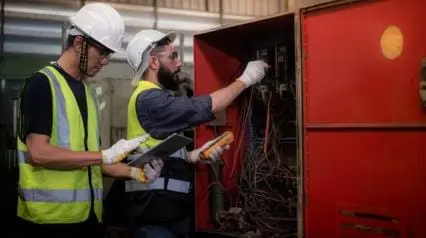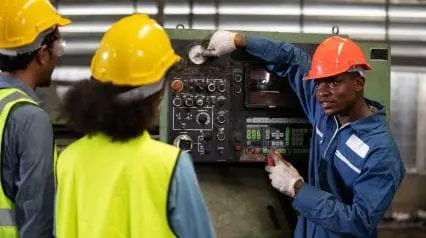What is Electrical Safety?
Electrical safety is a general practice for workers exposed to handling and maintaining electrically powered equipment. It’s a set of guidelines they follow to mitigate electrical hazards and prevent their dangerous effects in case of an incident. Failure to adhere to electrical safety can lead to accidents, near misses, or even fatalities.
Importance
In today’s technologically advanced world, electricity is a vital energy source that powers homes, offices, factories, and other industrial facilities. However, this resource can bring serious hazards—from electrical fires and burns to electrical shocks and fatalities—if not handled carefully. These dangerous incidents, in turn, can make a huge dent not only in the company’s finances but also in its reputation.
For this reason, basic electrical safety is of utmost importance in any workplace that utilizes electricity as a fundamental part of its day-to-day operations. This practice allows organizations to keep workers safe, carry out business functions smoothly, and avoid accidents.
Electrical Safety Regulations
Any workplace that utilizes or handles electricity in its daily activities must prioritize the safety of its employees and visitors. Electrical safety regulations play a pivotal role in setting the standards for a secure work environment, ensuring that organizations follow the necessary safety measures and best practices.
Be sure to refer to your local authorities for the laws and guidelines applicable to your jurisdiction and industry. To help you get started, here’s a quick overview of the electrical safety regulations from agencies around the world:
- United States – Occupational Health and Safety Administration (OSHA) standards for general and specific industries
- United Kingdom – Health and Safety Executive (HSE) standards and codes of practice
- European Union – Directive 2014/35/EU (Electrical safety: low-voltage electrical equipment)
- Australia – Model Code of Practice: Managing electrical risks in the workplace
10 Electrical Hazards to Watch Out For
One key aspect of electrical safety is knowing and understanding the potential risks that come with using electricity. If not addressed, these hazards present significant threats to the workers and properties of the organization.
Here are 10 electrical safety hazards to keep an eye on in the workplace:
- Overloaded circuits
- Faulty wiring
- Exposed electrical parts
- Improper grounding
- Damaged insulation
- Contact with live wiring
- Loose connections
- Wet environments
- Overhead power lines
- Damaged electrical tools and equipment
5 Electrical Safety Tips & Precautions
Electrical safety precautions are specific control measures implemented to remove electrical hazards and mitigate the risks of electrical accidents and injuries. Safety precautions for working with electricity depend on the worker’s job instructions and working environment.
Achieve optimal electrical safety at work by following these best practices:
Conduct a Risk Assessment.
Before implementing any safety measure, it’s important to understand first the electrical hazards present in the workplace. This can be done through an in-depth risk assessment.
Performing a thorough risk assessment can help organizations identify potential electrical hazards. This evaluation should cover all electrical equipment, wiring, and power sources. Once they’re determined, prioritize them based on severity and likelihood of occurrence.
Perform Electrical Inspections and Maintenance Checks.
Periodic inspections and maintenance are crucial to keeping electrical tools and systems in good working condition. Consistently carrying out these scheduled checks helps prevent damage, meet safety standards, optimize efficiency, and extend the lifespan of the system and equipment.
Before each use, employees must first inspect the equipment and report any problems they find. At an organizational level, it’s best to implement a routine electrical maintenance program. This way, electrical and maintenance teams can promptly address any identified issues to prevent accidents and breakdowns.
Create Your Own Electrical Safety Checklist
Eliminate manual tasks and streamline your operations.
Get started for FREEInvest in Electrical Safety Equipment.
One of the best ways to keep employees safe from hazards associated with their work is by equipping them with specialized personal protective equipment (PPE). Electrical safety equipment is specifically designed to protect workers from general and specific electrical hazards. Most workplaces should have the following safety gear:
- Insulated tools
- Insulated gloves
- Mats
- Eye protection
- Ladders
Safety equipment should also be used when doing specific types of electrical testing, repair work, installation, machine tasks, or maintenance, such as arc flash and customized earthing and short-circuiting, among others. And for an extra layer of safety, it helps to verify if your electrical equipment is certified by a nationally recognized testing laboratory.
Carry Out Safety Talks Regularly.
Electrical safety encompasses a wide area of general safety guidelines, such as electrical PPE and lockout/tag-out procedures, among others. Project managers, site supervisors, and safety officers can improve electrical safety onsite when they make sure that workers are adequately trained, team leaders regularly facilitate safety meetings, and teams talk about the specifics of a job (or have toolbox talks).
Listed below are a few examples of electrical safety topics organized by scope:
Toolbox Topics
- General Electrical Job- or Site-specific Safety Measures
- Working near High-voltage Energized Electrical Lines
- How to Deal with Downed Power Lines Safely
- Basic Arc Flash Safety Precautions
Meeting Topics
- Reviewing Sources and Causes of Electric Shock
- Safe Behaviors that Minimize the Risk of Electrical Injuries
- Effectiveness and Improvement of Electrical Safety Controls
- Lessons Learned from Electrical Incidents and Safety Outcomes
Knowing your limits and applying the best electrical safety practices can help reduce the risk of electrical shock and death. It’s safer to work within your scope of expertise instead of taking the risk of working beyond your capacity. If you’re not confident to do the job, don’t hesitate to call for help from an authorized person.
Provide Training on Safe Electrical Practices.
Proper training and awareness among employees are vital to building a safety-conscious workplace. Aside from the scheduled toolbox talks and safety meetings, it’s also important to conduct regular training sessions on electrical safety, covering the following topics:
- Fundamentals of Electricity and a Job Task or Site
- Hand and Power Tools Electrocution Prevention
- Identifying and Eliminating Common Electrical Hazards
- Emergency and First Aid Procedures for Electrical Accidents
FAQs About Electrical Safety
OSHA has established electrical standards to protect workers in construction, maritime, and general industries. These OSHA electrical safety standards are as follows:
- General Industry – Part 1910 Subpart S: Occupational Safety and Health Standards – Electrical
- Construction – Part 1926 Subpart K: Safety and Health Regulations for Construction – Electrical
- Maritime – Part 1915 Subpart L: Occupational Safety and Health Standards for Shipyard Employment – Electrical Machinery
These are anchored on the existing standards of the National Fire Protection Association (NFPA), specifically the National Electrical Code (NFPA 70) and the Standard for Electrical Safety in the Workplace (NFPA 70E).
The frequency of electrical safety training is highly dependent on the nature of work or the level of risks associated with a certain job. It should be determined and decided upon by the employer, manager, or other people in authority. OSHA also recommends that refresher training be provided at least once every three years to ensure that employees stay up to date with the latest safety standards and practices.
Performing electrical installations or repairs yourself can be risky, as these tasks require specialized skills and knowledge to ensure safety and compliance with local regulations. For safety and legal reasons, it’s generally recommended to hire a licensed electrician for any electrical issues.
The frequency of electrical systems inspections will depend on various factors, including the type of property, its age, its usage, and if there are any electrical issues.
In most cases, a routine check every 3-5 years is recommended for most properties. And for specialized structures, here’s a simple guide on when to do electrical inspections:
- Residential homes (new) – every 10 years
- Commercial buildings – every 3-5 years
- Industrial facilities – every 1-3 years




